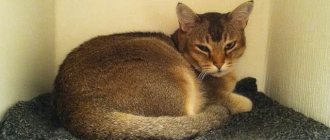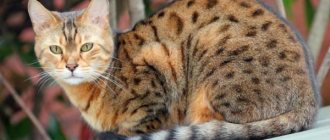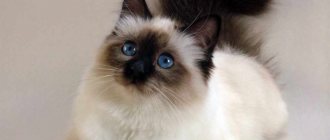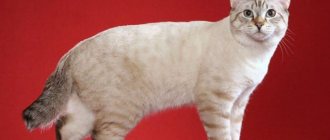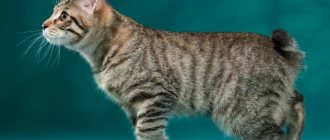Origin story
In fact, residents of Siberia had never even thought about the fact that their cats belonged to a certain breed. Such size and length of wool is rather a pattern in these parts, where winters are so severe that the animals had to adapt.
It is believed that a breed such as the Siberian cat originated from Bukhara cats. So these fluffies have a lot in common with Asian purrs. It was Asian traders who brought large, beautiful pets to the territory of Siberia. Local residents quickly dismantled them, since they could easily catch rodents.
Several years passed before the Bukharans were able to adapt a little to local living conditions. They grew fluffier fur and improved their hunting skills. A little later, the huge fluffy cats caught the eye of Russian merchants, who willingly took them for sale. This happened around the 16th century.
Thus, Siberian cats became widespread throughout Russia. They could be found both in huge palaces and in a small house in the village.
At the same time, Siberian cats appeared as a breed only towards the end of the twentieth century. Having carefully studied the characteristics of the purr, Russian felinologists successfully registered the breed in 1987. And 5 years later, Siberian kittens were included in the list of the World Organization of Felinologists. Since then, there has been a specific standard that characterizes the breed. This allows animals to take part in exhibitions and competitions.
By the way, there is also a version that Siberian cats descended from Norwegian cats brought to the territory of Siberia by settlers. However, this assumption was never confirmed.
Shedding
If you do not pay proper attention to your pet during this period, this may lead to the formation of tangles. In advanced cases, they can cover the entire body of the cat, creating a kind of shell, which can cause various skin diseases.
It is especially important to brush your pet thoroughly and daily at the very beginning of shedding. For cats living outside, branches of bushes and trees serve as combs. Dead pieces of fur remain on them while the animal walks.
Domestic cats have to be taken care of by their owners. Only daily brushing (especially for long-haired pets) can prevent matting and the formation of tangles.
Today, pet stores offer special food, as well as a paste for removing hair from the animal’s body. You can use such products during the molting period for preventive purposes.
Shedding is a natural process common to all animals.
However, owners of long-haired cats often notice that their pets' shedding seems to last all year round. This happens because the domestic cat constantly lives in a warm place, does not feel the reduction in daylight hours due to artificial lighting, and, if there is an air conditioner, does not feel the heat.
How to reduce shedding:
- brush your cat daily;
- if you feed your cat commercial food, buy food containing omega-3.6 fatty acids;
- Give your cat vitamins containing biotin regularly (2-3 times a year).
A noticeable deterioration in the quality of the coat can be associated with improper care of long hair, an inadequate diet, and various diseases (kidney failure, diabetes, hormonal disorders).
We suggest you read: Vaccination of cats and kittens - main viral infections, how to prepare an animal for vaccination
Also, heavy shedding begins when the cat is stressed.
Caring for a long-haired cat is not at all difficult if the cat is healthy, eats properly and is not overweight. Most cats love being brushed and will happily expose their backs and bellies to the brush.
And you only need a few minutes a day to care for your pet’s fur.
One of the basic rules for caring for cats is to maintain the animal's coat in perfect condition. Regular brushing, bathing and other procedures serve the following purposes:
- Maintaining order in the house. Caring for a cat's fur is beneficial not only for the animal itself, but also for its owners, and helps to minimize the amount of hair on the floor, upholstered furniture and other furnishings.
- The aesthetic side of the issue. Proper cat care prevents the formation of tangles and helps maintain the fur in perfect condition. Also, beautiful, well-groomed, clean wool is a prerequisite for participation in exhibitions for purebred animals.
- Cat health. While brushing the cat, the owner simultaneously massages the skin, which improves blood circulation and also helps remove flakes of dead skin. In addition, when combing, most of the hair remains on the brush, whereas when licking on its own, it ends up in the animal’s stomach. A buildup of fur in the stomach causes discomfort, negatively affects appetite, causes nausea and vomiting, and in worst cases can lead to serious digestive problems and intestinal blockage.
- Emotional contact. For many owners, caring for cats by combing turns into a kind of ritual, including not only carrying out the hygiene procedure itself, but also communicating with their pet. With the right approach, alternating the use of a brush with stroking and scratching with your hand, this procedure will be pleasant for the cat itself. At the same time, it is important to know the most sensitive places on the pet’s body and act carefully, trying not to cause pain or pull out living hairs or tangled tufts of fur.
Often, caring for a cat’s fur turns into not only useful, but also a pleasant time spent together between the owner and the pet.
Description and breed standard
The description of the Siberian cat breed correlates well with its habits and appearance. Breed characteristics include body size, head size, eye shape, tail and coat description. And so what breed standard does the fluffy beauty have:
- These are quite large animals. Body weight can reach 6–12 kilograms.
- Representatives have some features. Many have a massive neck, strong back, and toned stomach.
- The head is medium or large. This is influenced by the variety.
- The eyes are oval shaped.
- The ears are not big.
- Thick and long coat. Has a double undercoat. There are smooth-haired representatives.
- The tail is long, fluffy, large.
Despite the large amount of wool, the breed is considered hypoallergenic. Good for allergy sufferers.
Different types of Siberian cats have their own unique characteristics, ranging from the color of their fur coat to the presence of tufts on their ears.
Colors
The colors of the Siberian cat can be very diverse:
- The rarest color is white. A solid shade that should be absolutely pure. White representatives are also called Angora. The presence of stains is unacceptable according to the standard. A white cat may have honey, orange and blue eyes.
- Black Siberian. Another name for black marble. Quite a rare combination. Kittens are usually brown at birth, which subsequently darkens. This color easily fades in the sun, becoming a reddish tone. This is unacceptable for show cats.
- Gray Siberian. Representatives of this species are divided into smoky color and marble color.
- Tortoiseshell color. As a rule, these are three-colored pets. Combines red and black tones. The red part should not have any pattern, and the tones should be harmoniously located throughout the pet’s body.
- Black and white cat. Also has two color options. Black smoke covers the entire body of the animal in uniform spots. In the second option, the black marble shade affects only the face, ears, paws, tail and back.
- Smoky color. The shade is uniform, distributed over the entire body of the animal. The color of the coat is blue.
- Siberian color point or masquerade. Pets are born white; they get striped color much later.
- Golden color. Representatives are very beautiful, have red and brown spots.
- The tabby or patterned color is most suitable for the wild ancestor. Often found in Russian courtyards. A short-haired variation of this color is also possible.
Character and habits
The character of the Siberian cat fully corresponds to its name and pedigree. Habits and basic instincts make themselves known at the first convenient opportunity. The cat is a rat catcher and a real hunter. They are not afraid of dogs and bravely guard the territory from uninvited guests.
The animal is very smart, quickly gets used to its name and the place where the toilet is located. The Siberian breed is affectionate with people, but at the same time restrained. You can pet her only with her consent. A strong character does not interfere with getting along with kids.
Character and temperament
Siberians are active and playful cats with a developed sense of self-esteem. They are very reserved, talkative and subject to sudden mood swings. Representatives of the breed do not like it when communication is forced on them, but they themselves will not bother the owner when he is busy.
The proud and independent character of the Siberian cat does not interfere with getting along well with all members of the household, including children. The main thing is that the child understands that the animal is not a toy and knows how to properly handle the pet.
Siberians get along well with dogs and other cats. Despite their strong character, representatives of the breed do not strive to dominate other pets. True, the innate habits of a hunter prevent Siberians from being calm around rodents.
External features of the Siberian cat breed
| Breed name | Siberian cat |
| Time of origin | 16th century, breed recognition – 1987 |
| Country of origin | Siberia, Russia |
| Lifespan | 16-20 years old |
| Average weight | 6-7 kg (as an adult) |
| Average height | 35-40 cm |
| Cost of kittens | 400-500 dollars |
Wool
Siberian kittens are a long-haired breed. And this is putting it mildly - their fur is so thick that it requires special care. Of course, this length of fur coat is due to the fact that the kittens lived for a long time in severe frosts and were forced to adapt.
The Siberian's fur itself is quite coarse and tough. But the undercoat is soft and pleasant to the touch.
The fur of the Siberian cat is so tough that it is waterproof. This allowed the pets to catch fish in cold lakes and rivers.
Color
The Siberian breed of cats can be presented in absolutely any color. Their fur can be either plain or have certain patterns. It’s even difficult to say which color is most common.
Representatives of the color-point breed even received a separate name. Such Siberians are called “Neva masquerade cat”.
Tail
The tail is the real pride of the Siberian cat. It is very fluffy and even somewhat resembles the tail of a fox. The length of the tail is medium, its thick base tapers closer to the tip.
Eyes
Wide-set ones can come in a variety of shades. The shape of the eyes approaches a circle.
Ears
They are medium in size and widely set. It should also be noted that all representatives of the breed have ears slightly tilted forward. Their base is quite wide, but becomes noticeably narrower towards the tips. The tip of the ears is rounded.
Body
First of all, it is worth noting the dimensions of the case. The massiveness of the body is harmoniously complemented by its muscularity, which makes Siberians amazing hunters. The animals' paws are short, but also quite strong and muscular. Between the paw pads there are tufts of thick fur for added warmth. The chest of cats and kittens is quite massive.
Head
Wide wedge-shaped head. It has smooth outlines and is slightly rounded.
How to care for a Siberian cat
The Siberian's thick triple coat should be brushed a couple of times a week to prevent tangles or tangles. The coat will shed seasonally in the spring and fall, and you may need to groom more frequently during this time. A bath is rarely necessary, which is good because wool is very water resistant. Brush your teeth to prevent periodontal disease. Daily dental hygiene is a great option, but weekly brushing is better than nothing. Trim your nails every couple of weeks. Wipe the corners of your eyes with a soft, damp cloth to remove any discharge. Use a separate piece of tissue for each eye to avoid the risk of spreading infection. Check your ears weekly. If they look dirty, treat them with special lotions. Avoid using cotton swabs, which can damage the inside of the ear. Most of the Siberian's growth occurs in his first year and a half of life. Your kitten's breeder may recommend that you feed him food during this time to ensure he is getting enough food. Keep the litter box spotlessly clean.
Coloring and coat care
The Siberian is distinguished by a long triple coat with guard hairs (outer coat), ground hair (middle part of the coat) and a fluffy undercoat. It has abundant fur around the neck, dense but slightly shorter hair on the shoulder blades and lower chest, and thick fur on the belly and paws (upper hind legs). In cold weather the undercoat thickens. The coat comes in all colors and color combinations with or without white. Its head is a modified wedge with rounded contours - wide at the top and slightly tapering at the muzzle. The medium large ears are well supplied with tufts of fur. Almost round eyes can be green, gold, green-gold or copper. White Siberians or Siberians with white spots may have blue eyes. It can take up to five years for a Siberian to reach its full size. It has a muscular body, large round paws with tufts of fur, and a thick, shaggy tail.
How to choose a cat
A Siberian cat kitten can be weaned from its mother at the age of 3 months.
By this time, the animal will learn to lap up food from a saucer, use a tray, and acquire the necessary skills to communicate with other representatives of the animal world.
A healthy kitten should be active and cheerful
According to user reviews, the character of the Siberian cat changes slightly over time, so pay close attention to the behavior of the small animal.
If the pet is active and cheerful, you are lucky - the cat will be a wonderful pet.
But it is better to avoid purchasing lethargic and timid kittens; infantile fear can cause aggression and unsociability at an older age.
When choosing a baby in a nursery, focus on health certificates, check information about vaccinations performed and check that the documents are filled out correctly.
And when buying a cat remotely, be sure to ask for a photo of a Siberian cat in order to at least visually assess the animal’s compliance with the breed.
Small representatives of the Siberian cat breed
Character of the Siberian cat
We have already said that the Siberian cat breed originated in the wild. That is why they still have hunting instincts. In terms of their behavior in open spaces, these purrs have much in common with steppe and forest cats. Siberian kittens are real hunters, which they love to show at the first opportunity.
This is one of the few cat breeds that has a lot in common with dogs. Siberians also zealously guard their territories and are not happy with outsiders. In this case, aggression in animals is reduced to zero. At least from scratch. A pet can bite and scratch only if it is attacked. Moreover, in a fight such cats can be cruel.
Siberian cats have excellent sense of direction. They quickly remember where the house is and can calmly walk on their own, returning to their owners. Such fluffies are extremely rarely lost.
Siberian cats are especially kind to their owners. They quickly become attached and find a favorite among family members. Despite their independent nature, the animals are very friendly and sociable. They get along well with small children, although they do not allow kids to pull them by the tail and ears.
Conclusions about the breed
The Siberian cat received the right to wear a unique fur coat, which turned out to be easy to care for. The kitty takes excellent care of her coat herself. Another advantage of the breed is its high health indicator, provided that it is well cared for by the owner.
In a family, a cat quickly becomes a friend to every member of the household: it plays with children, gets along with other pets, and unobtrusively offers its company to everyone. In return, she expects only affection and attention!
Grooming equipment
Veterinary pharmacies offer a huge range of tools and products designed to care for the fur of a domestic cat. Depending on the length and type of fur, the following equipment may be needed to properly care for your cat:
- Brushes for combing. The frequency and shape of the teeth are selected based on the type of coat. The material from which the brush is made must have antistatic properties.
- Massage brushes. Massage the top layer of skin, improve blood supply to hair follicles, and also help remove dirt and dead skin particles.
- Combs with rounded teeth.
- Rubber brushes and gloves for grooming cats with short hair.
- Scissors with blunt tips for cutting tangles.
- Dry shampoo. Can be used as a replacement for bathing. It is produced in the form of a spray or powder, which after application to the coat must be thoroughly combed out. Contact of such products on the mucous membranes and genitals of cats is not allowed.
- Styling foam, grooming powder and other cosmetics are used to give the coat an ideal look before participating in exhibitions.
Conditions of detention and care
Ideally, a Siberian cat should live in a country house. There she will have more space for active games and walks in the fresh air. In addition, it is there that the fluffy will be able to embody all his hunting instincts and run after birds and insects.
Here are some more recommendations for caring for Siberian cats:
- If you live in an apartment, your Siberian needs to be walked regularly. To do this, you should buy a special leash. In order for the cat to feel freedom in the apartment, buy a special corner where the animals can climb.
- During the molting period, it is necessary to carefully comb the cat using special combs. You can even use a furminator. So that the cat is not afraid of the comb, it is better to start the procedure from an early age.
- Siberians love to swim, so you don’t have to be afraid of the animal. Water procedures are recommended to be carried out once every 2-3 months.
- You should not trim your cat's claws, especially if he goes outside.
As you can see, despite the long hair, the pet does not need to be washed too often. He is quite capable of taking care of himself on his own. The main thing is to promptly remove dead, flaky skin using special combs.
Be sure to keep your pet's ears clean and visit your veterinarian regularly for checkups. It is recommended to clean dirt from the ears and eyes using cotton wool soaked in clean water.
Care and maintenance
The Siberian is a long-haired cat adapted to harsh climates. You can keep it not only in an apartment, but also in a private house with access to a yard. Caring for a Siberian cat is generally simple and comes down to basic hygiene and proper feeding.
Hygiene procedures
To make a Siberian look attractive, you need to properly care for him:
Grooming
The shaggy Siberian requires more careful care than any short-haired cat. His thick coat is combed weekly with a special comb. During the molting period, the procedure is carried out more often in order to quickly remove dead hairs and keratinized skin scales.
The thick coat of the Siberian cat does not require frequent washing. But sometimes you can’t do without bath procedures. The Siberian is washed in a large basin with warm water. First, the cat's fur is thoroughly wetted, and then soaped and rinsed. The bathed cat is wrapped in a large towel, dried and released so that it is completely dry.
On a note. It is better to wash a Siberian black cat with a special shampoo for charcoal fur, which helps restore its natural color.
Tray
Siberians are large animals, so it is advisable to use a spacious closed tray as a toilet for them. But the type of filler is not so important. The main thing is that it copes with its functions and that the Siberian cat likes it.
basic information
Perhaps the most beautiful and vibrant Russian cat with a national character is the Siberian. These capricious furry treasures have long occupied a place of honor among all lovers of mustachioed and striped animals. But! Be careful! These cats are not so harmless and docile. Siberians can easily bring you half-dead birds from the balcony, or mice if you live in a country house. They are real hunters. Their scratchy paws can leave a single mark on a leg or arm if they are simply tired of playing with their owner, or they have not received their portion of attention for a long time. Yes, these cats are not for those who can just feed and clean the litter box!
| Breed | Siberian cat |
| Country of origin (Country) | Russia |
| When the breed was bred (Excretion time) | Unknown |
| Weight | 6-12 kg (6-12 kg) |
| IC code (EMS code) | SIB |
| Lifetime | 12-18 years old |
| Cost of a kitten (Price) | from 5,000 rub. (67-700 Euro) |
Bathing a cat
Some cats, including long-haired ones, sometimes need to be bathed. If your cat's fur becomes sticky or smells, a bath is a must.
Most cats do not like to bathe, and they need to be taught to take baths from childhood.
Now there are dry shampoos that do not require water to use. The powder is applied generously to the coat, and then combed out with a brush. Dry shampoo can add shine to the coat, remove excess oil and odor, but if the cat gets dirty, it will have to be bathed in water.
We suggest you familiarize yourself with: Biseptol. Biseptol for cats: purpose, use, dosage “Sinulox”: a medicinal product for cats
Conditioning sprays are also sold to prevent hair from matting. All these products make caring for a cat with long hair much easier, but cannot always completely replace bathing.
It is recommended to carry out this procedure no more than twice a year. To prevent bathing from causing discomfort to your pet, it should be done as follows:
- The best place to wash your cat is in a sink with a rubber mat placed at the bottom. Water is poured into it, the temperature of which is 38.3⁰C, and the animal is lowered, holding it by the scruff of the neck.
- Saying affectionately, very carefully moisten the fur on the entire body except the head, and apply shampoo.
- The foam is washed off with warm water from a shower hose.
- Wrap the cat in a large towel and gently wipe away dirt on the face with a moistened cotton swab.
- You need to wipe the animal with wet movements, trying not to make chaotic movements that contribute to the formation of tangles.
You can use a hairdryer to dry. Drafts should be avoided; after bathing, the pet should be placed closer to a heat source.
What to feed a Siberian cat?
Many owners of this breed are interested in what to feed their Siberian cat. In fact, representatives of this breed are not very picky when it comes to nutrition. They can easily eat the same things you eat.
Veterinarians recommend feeding Siberians with homemade food. The main thing is that it is of high quality. Your pet's diet must include lean meat, poultry, and lean fish. By the way, the Siberian cat loves fish products (especially shrimp) most of all. She can even catch fish on her own.
In order for the fluffy to receive all the necessary microelements, it is also important to add egg yolk and dairy products (kefir, fermented baked milk, yogurt, cottage cheese) to the diet. Avoid cow's milk, it is better to replace it with goat's milk.
Your pet should get carbohydrates from porridge (oatmeal, buckwheat, rice). You can dilute natural nutrition using special dry food. Choose premium or holistic products. It is advisable to take a closer look at a diet that helps remove hair from the stomach.
Also read: Cat food rating 2019
Nurseries
If you have decided to buy a Siberian kitten in a specialized Siberian cattery, then I want to please you: now there are many catteries. These nurseries are located in different countries of the world:
- in Russia (Moscow, St. Petersburg, Yekaterinburg, Nizhny Novgorod, Chelyabinsk, Kazan, Novosibirsk, Voronezh, Perm, Saratov, Krasnoyarsk, Tyumen, Yaroslavl, Ufa, Penza, etc.);
- in Belarus (Minsk, Brest, Mogilev, etc.);
- in Ukraine (Kyiv, Kharkov, Dnepr, Lviv, etc.);
- in the USA (New York, Los Angeles, Dallas, Las Vegas, etc.);
- in Canada (Toronto, London, Montreal, Calgary, Ottawa, etc.);
- and in many other cities and countries!
My cattery is located in Saratov (Russia), but I will help organize delivery of the kitten to you, even if you live in another country. Now Siberian kittens from my nursery live in many parts of the European Union, in the USA, in Canada, in Colombia.
Here on this page you can see the geography of graduates of my nursery, as well as kittens available for sale now: link
Health and diseases of Siberian cats
Unlike some cat breeds, Siberian pets are quite healthy. They have no predisposition to genetic diseases, and the average life expectancy is 16-20 years. The main thing is to monitor your furry friend’s diet and properly care for him. Otherwise, with age, the animal may develop problems with the gastrointestinal tract or heart disease.
In rare cases, Siberians have an allergic reaction to pollen or dust in the home.
To improve your animal's health, regularly carry out helminth prevention and vaccination. This way you can prevent serious illnesses.
Health of Siberian cats, life expectancy
Siberian cats boast good health and strong immunity. Perhaps, thanks to the harsh climate of Siberia, the animals managed to harden well. Among all the diseases that can affect the life expectancy of an animal, one can note urolithiasis and a tendency to clog the intestines with hair. The reason for such health problems is the animal’s poor nutrition, as well as the lack of proper care.
In addition, in the absence of a balanced diet, metabolic processes in the body are disrupted in cats, which leads to excess accumulation of fat. If an animal is obese, breathing becomes impaired and the pulse becomes rapid. The cat stops actively moving and becomes lethargic. Normalizing the diet and active games with the animal will help solve the problem.
Some cats may become hyperactive. This behavior most often occurs in animals that spend a lot of time alone. A sufficient amount of attention from the owner will help solve the problem.
Siberian cats have good health
If the owner pays due attention to his pet, then all health problems diagnosed at an early stage can be treated well with medication. The average life expectancy of Siberian cats is 15–17 years, but there are also long-livers, whose age reaches 20–25 years.
Features of character and behavior
Siberians have a Siberian character, which is manifested in the following traits:
- sociable, but not annoying;
- independent;
- smart;
- balanced, friendly;
- curious;
- brave.
The Siberian cat has a stern appearance, which can create a deceptive impression. Yes, these cats are stingy with emotions, but they are very kind and love affection from their owner. But they can also show independence. You can’t force hugs or scratching behind the ears on them if they don’t want it.
Mutual respect and understanding are the basis of relations with a Siberian. The cat will not bother you when he sees that the owner is not in the mood, but in return he “hints” at the same attitude towards himself.
Siberian cats are calm and balanced and all because they are aware of their strength.
They get along well with other pets, but they immediately make it clear who is in charge in the house. It's difficult to argue with such a giant. He is friends with children, but will not tolerate mischief on their part. In a family, a Siberian chooses only one person whom he will consider equal to himself. They are wary of strangers and display the habits of a security guard.
In their reviews, the owners note that Siberians are very smart. And they tell incredible stories about cats’ abilities to open doors, check for food in the refrigerator, etc.
Combing
This procedure, carried out regularly, helps protect the coat from parasites and dirt. In addition, blood flow to the hair follicles as a result of massage with a comb improves the condition of the coat.
It is recommended to carry out the combing procedure when the cat is in a calm, relaxed state. It’s good if she is accustomed to this from childhood. Brush the animal in the direction of hair growth from head to tail, then the hind legs and lower part of the body.
The care requirements for short-haired and long-haired cats have significant differences:
- Short-haired cats with a single-layer coat structure (British, Siamese, Rex, Burmese) are first combed against the grain and only then smoothed from head to tail. It is enough to comb them once a week.
- Among shorthaired cats, there are breeds that have a thick undercoat (Russian Blues, Abyssinians, American Shorthairs). The rules are the same, but here it is especially important not to damage the long hairs that create a certain color of the animal.
- Long-haired breeds (Angora, Persian, Siberian, etc.) require more careful care. Brush them daily, doing this with extreme caution. At the end of the procedure, the shoulders and head are combed upward, thus creating something like a crown around the head. In cats with long hair, tangled mats can often be found. If you can’t comb them, then scissors will come to the rescue.
When the procedure of combing wool becomes a familiar daily ritual, a special psychological mood is established between the owner and the pet.
But for this to happen, you need to start doing this from the first days the kitten appears in the house. For kittens, all the actions of the owner are a continuous exciting game, and they are happy to join in it. An older animal can also be trained to comb.
If you do this procedure daily, the cat will quickly get used to it and will enjoy scratching.
Brush selection
Before combing the wool, you need to purchase a special tool. It is recommended to choose combs for cats that are not capable of harming the delicate skin of the animal. Brushes made of synthetic materials are usually used.
The main thing is that they do not cause static electricity. Iron brushes are intended mainly for dogs, while wooden brushes become unusable very quickly.
We suggest you read: Is it possible to sterilize a pregnant cat?
In accordance with their purpose, combs differ in shape and frequency of teeth. Some of them are only suitable for combing wool. Others additionally have a massage function, providing blood flow to the hair roots. As a rule, they have sparse teeth, with rounded ends.
It makes brushing your pet much easier. The advantage of the furminator is that it carefully pulls out the dead undercoat without damaging living hairs.
Many long-haired cats require daily brushing, otherwise their fur will quickly become matted.
To groom your long-haired cat, you will need three types of brushes: a soft brush, a metal round-tooth comb, and a slicker brush. Sometimes a tangle cutter may be required.
Double sided brush
It is better to brush your cat daily - in this case, grooming will only take you a few minutes.
Gently run the brush over the back, belly, tail, chin and paws. A comb with metal teeth is needed to comb out small tangles.
Metal comb
Once you have identified the mat, gently pinch the fur with your fingers near the skin and begin to slowly comb out the mat. If you have missed a few days, the tangle may be large - then you will need a tangle cutter.
Colt cutter
It will cut the hairball into several small ones that you can either pull out with your fingers or comb out with a round-tooth comb.
After brushing, run a slicker through the coat to remove any fine fluff and smooth the coat.
Slicker brush
It is recommended to accustom your cat to brushing from childhood. Experienced owners recommend that at first they choose the time for the procedure shortly before meals, so that the kitten will form pleasant associations with combing. In the future, when the cat is no longer afraid of the brush and other equipment, cat grooming can be done at any time (the only condition is that the pet is calm, otherwise he will try to turn the hygiene procedure into a fun game with the owner and the brush).
Having prepared all the necessary accessories, you can start combing the cat:
- A calm animal is placed on your lap or on a comfortable wide bedding.
- If your cat is still afraid of brushes, you can purchase a mitten-shaped brush. Thanks to this shape, the cat will get the impression that it is being petted, and at the same time, the mitten will help remove already fallen hairs from the surface of the fur.
- Comb with a wide-toothed comb in the direction of hair growth. A comb will help untangle long hair and identify tangles.
- Cut out tangles with scissors with blunt tips.
- Proceed to combing with a fine-toothed brush. The direction of movement of the brush depends on the length of the coat and the breed of the cat, for example, short-haired animals are first combed against the hair and only then in the direction of its growth, and in some breeds a lush “collar” is formed at the final stage of combing.
Particular care should be taken when combing sensitive areas of the cat’s body (the tummy, the genital area, and in long-haired breeds, the “pants” on the hind legs).
The frequency of brushing depends on the length of the coat. For long-haired cats, the procedure is performed daily, for short-haired cats – once or twice a week.
Photos of Siberian cats
Just look what handsome men and beauties are in front of you. Siberian cats can differ in different colors, however, regardless of this, they all look simply luxurious. Among the most popular colors of animals are:
Siberian color point cat:
Red Siberian cat:
Black Siberian cat:
Siberian cat white:
Siberian cat gray:
Siberian cat tortoiseshell color:
Estimation of breed characteristics
The breed belongs to the semi-long-haired cats. Their fur coat is warm, thick, and can withstand any frost. Fluffy tails are so aesthetically pleasing that it is impossible to take your eyes off them. Medium-sized ears, bright eyes and powerful paws create the image of a Russian cat, which is so popular here in Russia.
The characteristics as such can be seen below:
| Pet adaptability | High |
| Animal molt | Average |
| Mimimeter | Average |
| Need for communication | Average |
| Need for grooming | Average |
| Friendliness in an unfamiliar environment | Low |
| Child Friendly | Average |
| Dog Friendly | Low |
| Intelligence of the Siberian cat | High |
How much do Siberian kittens cost?
The price of Siberian kittens will depend on their pedigree, color or gender. In general, the cost is quite affordable. However, it is important to ensure that you get a good breeder. Often scammers sell simple fluffy kittens, calling them real Siberians.
It matters here whether you plan to breed kittens in the future or just want a furry friend. If the first option suits you, the cost of the pet will range from $300 to $500. But kittens with some discrepancies with the breed standard (cannot be used for further breeding) cost even less - about 100-200 dollars.
Veterinary care
The Siberian kitten is a living creature that requires proper care. Proper care is not only proper (balanced nutrition) and constant access to water, but also timely veterinary care and the correct way of keeping it. You should also not forget about comprehensive annual vaccinations, as well as timely veterinary care for your furry miracle! Do you have any questions about the care, feeding and maintenance of a Siberian kitten? Ask me a question that interests you - I will advise you as soon as possible. Fill out the form - send your question: I advise my customers not only at the stage of purchasing an animal. If you have any questions after the Siberian kitten arrives at your home, I will advise you at any time!
